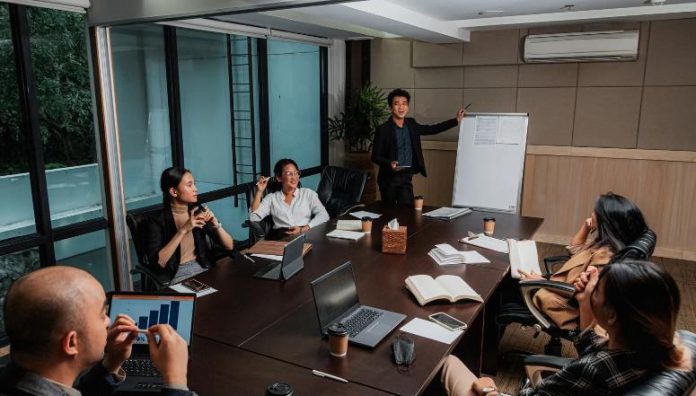Table of Contents
Inclusive meetings are effective meetings. Here’s how you can use DISC profiling to ensure your meetings are working effectively.
Despite being a mainstay of our working lives, meetings are a contentious topic. Some people love meetings; others hate them. And too often, meetings don’t live up to their potential due to inefficiency, confusion, and poor planning.
One of the biggest reasons that meetings fail to be effective is because they are not inclusive of different personality types. Geared primarily towards loud, outspoken, and sociable personality types who prefer fast actions and big decisions, meetings are often dreaded by quieter individuals who like to take their time to ponder a problem thoroughly.
So, how can you make your meetings more inclusive for everyone in order to get the best results? One of the best ways to start is using DISC.
What is DISC?
First proposed by psychologist William Moulton Marston in 1928, DISC theory is a way of understanding different behavioural styles. Now used in workplaces all over the world, the DISC assessment is a questionnaire used to identify the single or multiple behavioural styles that individuals fit into.
The four personality profiles in DISC are:
Dominance

Decisive, ambitious, and independent, people with the Dominance personality type are go-getters who know what they want and work hard to achieve it. They prefer to work alone, not wanting to be held back by anyone else, but they’re good at delegating tasks to others if it means they achieve their goals more effectively. With a competitive edge and an assertive communication style, these individuals are often good leaders, negotiators, and big-picture thinkers.
Influence
Bursting with energy and enthusiasm, Influence type personalities are at their best when working closely with other people and motivating their team. They often have a positive, sunny disposition and enjoy looking on the bright side, which means that they’re great at keeping up team morale but sometimes have a tendency to generalise or overlook key details. Good at making sure everyone feels included and valued, Influence types are great team players.
Steadiness

Although people with the Steadiness personality may seem a little reserved or even private at first, once you get to know them you’ll realise that they’re warm and caring people. Valuing stability, caution, and positive working relationships, people with the S type are important members of any team. They’re dependable workers who are democratic and fair, keeping teams on track with their reliable work.
Compliance
Meticulous, analysing, and sometimes slightly perfectionistic, Compliance types are often the independent workers who keep an eye on all the important but overlooked details. They’re often found asking lots of in-depth questions and looking at problems with perspectives nobody else has considered. C styles care deeply about accuracy and precision, making them a great force for success on any team. Task-oriented and good at solving problems, they’re a real asset to the organisation.
So, with these four different behavioural styles in mind, how can you make meetings more inclusive for everyone? Here are three useful tips.
Making Meetings More Inclusive for Different Personality Types
1. Provide a detailed agenda ahead of time
One of the simplest but most effective ways to make your meetings more inclusive to all personality types is by sharing a clear and detailed agenda in advance of the meeting. In addition to ensuring that the meeting stays on track and doesn’t fall into irrelevant discussions or miss out important points, a written or visual agenda can help make the meeting more inclusive for various personality types.
For example, D types are most comfortable in meetings when there is a clear agenda that everyone sticks to, allowing big tasks, decisions, and problems to be discussed without devolving into distractions or small talk. People with the Dominance personality are often frustrated by irrelevant chatter, becoming impatient and sometimes coming across as rude towards their more people-oriented coworkers such as chatty Influence types. With an agenda, it’s easier for everyone to stay on track, saving the friendly conversation for before or after the meeting.

Similarly, S types appreciate structure and harmony in the workplace – they don’t respond well to chaotic or confusing meetings where people flit between different points or tasks. Providing a written agenda beforehand allows slower-paced S types to become acquainted with the material and tasks at hand and ensures there’s adequate opportunity to address them all calmly and at a moderate pace within the meeting.
For C types, who are meticulous and like to consider all perspectives before making decisions, providing an advanced agenda is a good way to give them time to research, analyse, and consider the tasks or problems at hand. This means that they can arrive at the meeting feeling comfortable that they have all the information necessary to move forward.
And for I types, who love meetings for their social and collaborative aspect but struggle to engage with the boring nitty gritty details, an agenda can be an effective way to keep them on track.
Moreover, asking team members to contribute to the creation of the agenda items encourages them to take ownership of the meeting points, allowing for greater engagement in the meeting. It’s a great way to ensure that everyone prepares effectively so the meeting itself runs smoothly.
2. Structure the meeting so everyone gets a chance to share
One of the common problems with meetings is an imbalance in how much people contribute; you may have one or two people who speak up all the time and the rest who remain silent unless specifically called on. While there’s nothing wrong with either being a confident speaker who participates in the discussion or being a quieter person who prefers to think before speaking, there are some issues that arise when meetings are always unbalanced.
Firstly, the team misses out on the useful insights and suggestions that come from those who dislike speaking up. With fewer perspectives being shared, teams can find it harder to solve problems creatively or come up with new ideas.
The second problem that arises when some members of the team talk more than others is that it can breed resentment on both sides, sometimes leading to conflict within the team. ‘Why does she always talk so much in meetings? She’s dominating the discussion,’ one quieter S type individual might think.

On the other hand, the more active participants in the discussion may feel like their quieter colleagues aren’t pulling their weight. ‘Why does nobody else ever share ideas? Must I always do all the work?’ an outspoken I type team member might think. These unspoken resentments can lead to damaged morale and poor collaboration, limiting the effectiveness of the team. And sometimes they even boil over into interpersonal conflict.
The answer to this problem is structuring meetings in a way that encourages sharing from everyone in the ways they feel most comfortable. For example, while D types and I types are often happy speaking in front of big groups, more reserved S types and C types might shudder at the idea of having to argue their point in front of the whole team.
To ensure everyone can be heard, it can be useful to dedicate parts of the meeting to smaller group discussions where two, three, or four team members can share ideas and solutions before feeding back to the rest of the team. Or, you might sit everyone in a circle and make sure everyone is called on to talk in turn, ensuring everyone can be heard.
Moreover, it’s useful to consider different meeting formats which provide opportunities for everyone to participate, even if they dislike speaking up in front of the group. For example, in a team ideation session, some individuals may be reluctant to share ideas out loud in front of the whole group, but might be happy to write the good idea down on a piece of paper or (in the case of online meetings), post it in the chat instead of turning their mic on. This ensures that the meeting isn’t always dominated by the outspoken and loud personality types, giving everyone an opportunity to have their say.
3. Help team members better understand each other with DISC
DISC theory isn’t just useful for planning meetings; it can also be beneficial for helping all employees approach meetings more productively. With a good understanding of their own DISC styles and those of their coworkers, employees can identify their own strengths and limitations when it comes to meetings and build teamwork. Eventually, after some DISC training, this will come naturally to team members and help everyone participate more effectively in meetings.
Here’s an example. Consider a Compliance type who often feels frustrated in meetings. As meticulous independent workers with a perfectionist streak, meetings may seem inefficient to C types. They might feel like details are too often glossed over in favour of big ideas from D types and generalisations from I types. Their frustration with meetings may lead to them trying to avoid them wherever possible and participating very little in them.

However, with an understanding of DISC, the C type can start to approach meetings more productively, addressing their own need for lots of information by preparing extensively with lots of research before meetings and then sharing the key findings with the group. This means that instead of feeling frustrated about key details and information being ignored, the C type can take ownership over the key points.
Moreover, by understanding their coworkers’ DISC profiles, the C type may realise that what they previously perceived as inefficient chit-chat was actually their I and S type coworkers’ way of maintaining strong working relationships for better collaboration. With this understanding, the C type can see the value in the small talk and participate more fully in the social aspect of meetings.
It’s similar for D, I, and S types: understanding your own personality and the different personalities that make up the team is a productive way to get the best out of meetings.
Conclusion
Overall, meetings are only as effective as the people who run them and participate in them. In order to get the best results from your team meetings it’s essential to make them inclusive to all, regardless of personality type.
Interested in using DISC to unlock the potential of meetings in your organisation? Visit DISC Group. With a range of personalised DISC reports for individuals, teams, and even leaders, in addition to training and certifications, DISC Group has everything you need to enhance your organisation with personality profiling.


